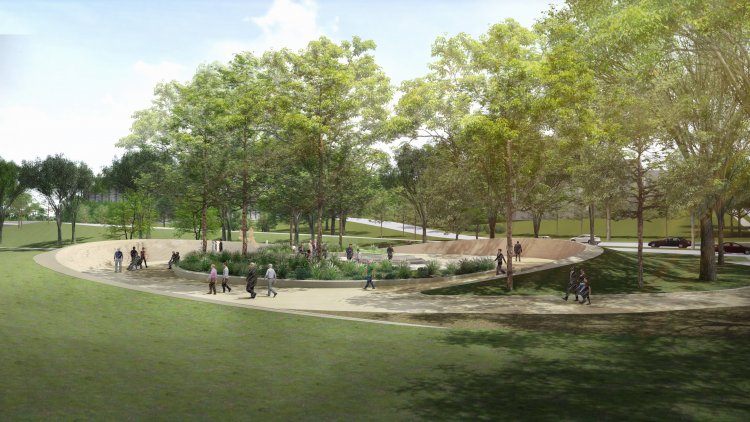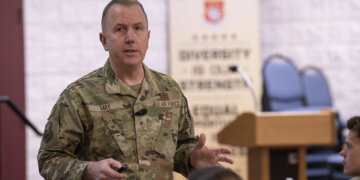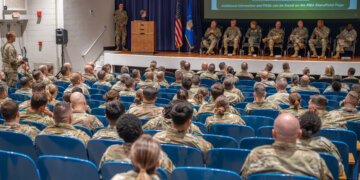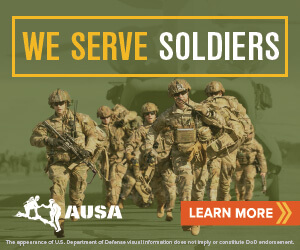This article was originally published on July 11, 2022, and has since been updated.
When Scott Stump was pulled from his final college course and activated in the Marine Corps Reserve to support Operations Desert Storm and Desert Shield, he “full-well expected” there was a chance he wouldn’t come home.
“There are a lot of us, and I can remember when we got the call — it was like, ‘Prepare to be gone a minimum of one year… Nobody could have foreseen this to be the rapid and resounding success that it was,” said Stump, a SAW gunner with the 3/24th Marines, Gulf Company, a reserve unit out of Danville, Illinois.
He was among those who served in the 35-country coalition that liberated Kuwait from Iraq — a mission that cost more than 200 U.S. service members their lives – and lasted 100 hours.
Stump said he remembers receiving “the talk” of “look to the left, look to the right, one of you isn’t coming back.”
“I think the most vivid memory would be the uncertainty,” Stump said.
And since 2011, he has worked to recognize those who served and to the lives lost through his work as the CEO and president of the National Desert Storm and Desert Shield Memorial. The memorial itself recently underwent a name change to Desert Shield and Desert Storm Memorial.
The National Park Service agreed with the memorial association’s recommendation to list the operations in order of occurrence, according to a December 2022 news release.
“The NPS also recommended removal of the word ‘national’ in order to maintain consistency with established war memorials on the National Mall and within Washington D.C.’s monumental core,” the release stated.
‘That little hundred-hour war’
On the cusp of the Gulf War’s 20th anniversary, Stump realized that his children — and most Americans — “didn’t either have any idea what happened then or referred to it as that little hundred-hour war and nobody died.”
Others, he said, “conflated it with post-9/11 military actions” (also named Operation Desert Storm), when the mission was to liberate Kuwait.
“There were 700,000 Americans that answered a call,” Stump said. “Nobody expected it would be over with the rapidness and conclusion that it came to.”
Paul Maldonado, an Army veteran who served with the 3/37th Armored Regiment out of Fort Riley, Kansas, under the 1st Infantry Division, was among those deployed. In addition to serving as a cook with a frontline support unit, Maldonado said he was assigned with a fueler to ride shotgun and was part of a burial detail. He’s thankful now that those who served during the war are being recognized.
“I really do hope there’s an opportunity for not only our young people to take notice of the sacrifices that were made… but also an opportunity — and I’m speaking to this firsthand — also an opportunity for fellow veterans to connect through this,” he said. “And I’m speaking out of experience only because since that event, I’ve probably only reconnected with one other troop, and I haven’t really been able to locate anyone else.”
Anniversary connection
Kyle Leggs, who served from Sept. 13, 1990, to May 25, 1991, with the 200 TC Detachment in southwest Asia, attended that same 20th anniversary commemoration of the Gulf War in Indianapolis, where he met Stump. Leggs was soon asked to join the memorial’s team as director of planning.
“I knew it would be sort of a once in a lifetime undertaking, so, my background — I’ve been a city planner for the past 25 years – I thought I could lend to the cause. And really just be a part of what’s going to be a memorial that’s going to be on the National Mall for generations to come,” he said.
In addition to reaching out to others who had served, Stump said he did the “real heavy lifting” that came with the legislation required to construct a monument in Washington, D.C.
RELATED: Hershel ‘Woody’ Williams, last WWII MOH recipient, dies at 98
“[The monument] had to be in Washington because that’s where significant and important stories are told,” Stump said. “That’s the stage where that happens.”
Stump said he didn’t have a “sophisticated network,” so to get congressional eyes on the measure, he went “door-to-door and from member-of-congress to member-of-congress.”
In June 2013, Rep. Phil Roe (R-Tennessee) introduced the National Desert Storm and Desert Shield War Memorial Act, which allowed the memorial to be established on federal land in Washington, D.C. Nearly one year later, the measure was unanimously approved and then signed into law in December 2014 by President Barack Obama.
President Donald Trump signed a separate bill in March 2017 that allowed the memorial to be constructed near the National Mall. The groundbreaking ceremony will be held on July 14 at 23rd St. and Constitution.
Leggs said that while the board spent several years looking at other sites in Washington, D.C., they secured the current location “after some long-fought battles.”
“We worked closely with our architects as well as the National Parks Service in terms of the reviews for the memorial and the design and so it’s been a really lengthy process,” he said.
Desert Shield, Storm ‘major and significant event’
Operations Desert Storm and Shield were a “major and significant event” with lasting repercussions, according to Stump.
“People overlook the fact that Desert Storm forever changed the relationship between the American public and not just those who currently serve in uniform… but those that did serve,” he said.
Early in the design process, veterans of Operations Desert Storm and Desert Shield answered a survey, which helped guide the look of the memorial.
“It was really our way of ensuring that we were capturing the sentiments of the war itself,” Leggs said. “Not only the war but the environment … [We were] making sure that this memorial with those questions was really unique to the experience of fighting a war in the desert.”
Stump said he stuck with the memorial plan out of a sense of obligation and commitment to the board of directors, design team and others who have supported his vision.
“It’s been a very long, excruciating process at times,” he said. “It’s taken, and I knew it would take a good bit of time, but I could never have foreseen difficulties, heartaches, things that we’ve had to overcome.”
For example, the standard NPS process to select a site location takes 18 months, but Stump said it took 39.
But his only motivation was to bring the memorial to fruition.
“[There’s] nothing I’m getting personally out of it… [just the] satisfaction of knowing that this very, very important event and all of those who served and who subsequently died are never going to be forgotten,” Stump said. “So, I know as long as there’s a Washington, D.C., this story and those involved are going to live on.”
The memorial is expected to be completed by Veterans Day 2024.













































